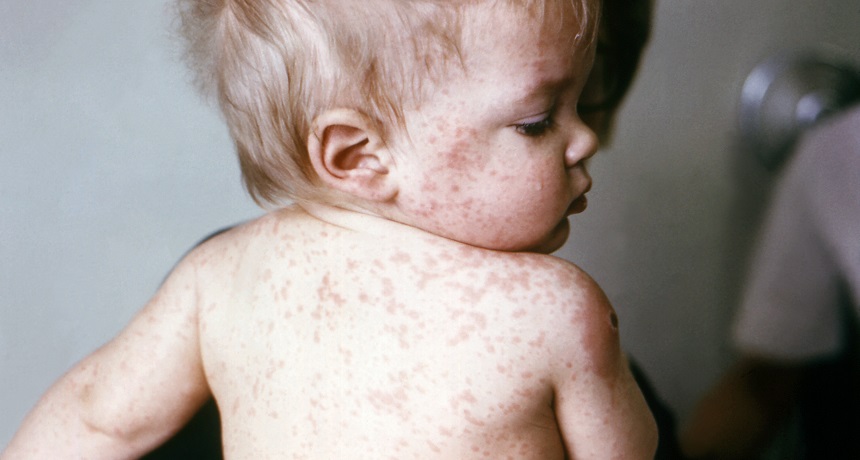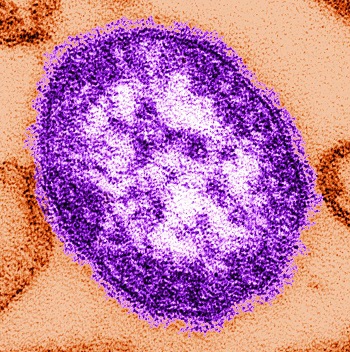U.S. outbreak of measles emerges
Most patients never received the vaccine to prevent this serious disease

Toddler with measles in a photo from the mid-1960s. Since a vaccine became available in 1963, U.S. measles infections have plummeted. But people who never were vaccinated still can pick up this sometimes deadly virus.
CDC
Measles loves a crowd. Some visitors to southern California theme parks have just learned this the hard way.
Epidemiologists are disease detectives. They trace sources of disease. And they have just tracked a major outbreak of measles to two Disney theme parks. Tens of thousands of people each day visit these parks from all over the world. That can give any contagious virus access to plenty of new hosts.
Sixty-seven cases of measles have been reported among visitors who went to either Disneyland Park or Disney California Adventure Park. They account for most of the recently confirmed U.S. cases of measles.
“We aren’t sure exactly how this year’s outbreak began,” says Anne Schuchat. She is director of the National Center for Immunization and Respiratory Diseases. It’s part of the Center for Disease Control and Prevention, or CDC, in Atlanta, Ga. “We assume that someone got infected overseas, visited the parks and spread the disease to others,” she says.Already, more than 100 U.S. measles cases have popped up in 2015. The patients come from 14 different states. Through surveys and interviews, epidemiologists quickly learned what linked most of the group: They had been to one or both of the adjacent Disney theme parks between December 17 and 20. Most were tourists, but some park workers also fell ill.
Since the beginning of January, “We identified a cluster of measles cases,” says Gil Chavez. He’s California’s state epidemiologist. And the only thing they had in common, he says, was “a December visit to Disney theme parks.”
Tracing a disease to its source helps prevent its broader spread. As part of their sleuthing, epidemiologists typically ask patients if they recently traveled through an airport or other places with crowds of people from different countries. Disneyland fit the bill. It is popular with tourists from all over the globe.
Although vaccinations had virtually erased measles from the United States, the disease continues to sicken people in many other countries. And its virus is highly contagious. People pick it up through the air. You can get measles just by being near an infected person, CDC notes. You also can get it just by being in a room where an infected person coughed or sneezed within the last two hours.

“This is not a problem with the measles vaccine not working. This is a problem of the measles vaccine not being used,” the CDC’s Schuchat explains.
Some people who got infected were too young to be vaccinated. Others had been too sick. Still others may not have been vaccinated for family reasons. For instance, some people fear that vaccines can lead to autism. A 1998 study did made that claim. But — and this is critical — that paper was later retracted. A follow-up investigation called the study “fraudulent.” The journal that had published the first paper withdrew it. And the paper’s British author now is banned from practicing medicine.
Multiple other studies since then have found the vaccine both safe and effective, notes Errol R. Alden. The physician is executive director of the American Academy of Pediatrics, based in Illinois.
“Getting the measles vaccine is much safer than getting the measles infection,” he says.
Guarding the “herd”
And vaccinations don’t just help the people who get briefly jabbed with a needle. They also can protect entire communities. Doctors call this “herd immunity” or “community protection.”
But herd immunity only works when enough people get vaccinated.
For a disease like measles to survive, someone who is sick has to spread the virus to someone who is susceptible. That second person has to do the same, continuing the chain of transmission, explains Walter Orenstein. This physician is a vaccine expert at Emory University in Atlanta, Ga.
“If I come into contact with an immune individual, that chain is broken,” Orenstein tells Science News for Students. But herd immunity occurs only “when you have high levels of immunity in a population.” Then, he says, “the likelihood I will find a susceptible [person] goes way down.
Measles is so contagious that its spread can occur unless about 92 percent to 94 percent of all people are vaccinated, CDC says. But when that level of vaccine use does occur, in theory measles eventually can be wiped out.
Vaccinating large numbers of people will “act as a firewall,” explains Jorge Parada. It will guard most if not all unvaccinated people. Parada is an epidemiologist with the Loyola University Health System in Maywood, Ill.
In some pockets of the United States, the percentage of vaccinated people is much smaller than that ideal number. Get enough of these unvaccinated people together, expose them to someone infected with measles and the virus will start to spread. That appears to be happened in the Disney theme parks. And it will continue to happen elsewhere if infected tourists carry home the virus to communities where vaccination rates are low.
Looking ahead, health officials worry that the current measles outbreak means mumps and rubella cases may spike as well. The reason: The same vaccination delivers protection against those formerly serious childhood diseases as well.
“Measles is a warning sign and what we want to do is take action to correct it, before we start seeing all sorts of other diseases returning,” Orenstein says.
And as for Disneyland, airports and other crowded areas: They are safe to visit — if you’ve been vaccinated.
Power Words
(for more about Power Words, click here)
autism (also known as autism spectrum disorders) A set of developmental disorders that interfere with how certain parts of the brain develop. Affected regions of the brain control how people behave, interact and communicate with others and the world around them. Autism disorders can range from very mild to very severe. And even a fairly mild form can limit an individual’s ability to interact socially or communicate effectively.
Centers for Disease Control and Prevention, or CDC An agency of the U.S. Department of Health and Human Services, CDC is charged with protecting public health and safety by working to control and prevent disease, injury and disabilities. It does this by investigating disease outbreaks, tracking exposures by Americans to infections and toxic chemicals, and regularly surveying diet and other habits among a representative cross-section of all Americans.
contagion A disease that can be spread by direct contact with an infected individual or the germs they spread into the air, their clothes or their environment. Such diseases are referred to as contagious.
epidemiologist Like health detectives, these researchers figure out what causes a particular illness and how to limit its spread.
immune Able to ward off a particular infection. Alternatively, this term can mean to show no impacts from a particular poison or process. More generally, the term may signal that something cannot be hurt by a particular drug, disease or chemical.
immunity The ability of an organism to resist a particular infection or poison by producing and releasing special protective cells.
infection A disease that can spread from one organism to another.
measles A highly contagious disease, typically striking children. Symptoms include a characteristic rash across the body, headaches, runny nose, and coughing. Some people also develop pinkeye, a swelling of the brain (which can cause brain damage) and pneumonia. Both of the latter two complications can lead to death. Fortunately, since the middle 1960s there has been a vaccine to dramatically cut the risk of infection.
outbreak The sudden emergence of disease in a population of people or animals.
pinkeye A highly contagious bacterial infection that inflames and reddens the conjunctiva, a membrane that lines the eyelids’ inner surface.
pneumonia A lung disease in which infection by a virus or bacterium causes inflammation and tissue damage. Sometimes the lungs fill with fluid or mucus. Symptoms include fever, chills, cough and trouble breathing.
transmit To send or pass along.
vaccineA biological mixture that resembles a disease-causing agent. It is given to help the body create immunity to a particular disease. The injections used to administer most vaccines are known as vaccinations.
virus Tiny infectious particles consisting of RNA or DNA surrounded by protein. Viruses can reproduce only by injecting their genetic material into the cells of living creatures. Although scientists frequently refer to viruses as live or dead, in fact no virus is truly alive. It doesn’t eat like animals do, or make its own food the way plants do. It must hijack the cellular machinery of a living cell in order to survive.







